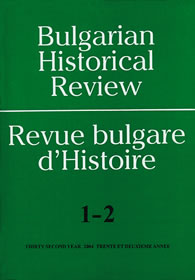Арменци и аджем туджари (За статуса на търговеца в Румелия през XVII-XVIII в.)
Armenians and Acem Tucars (On the Status of the Merchant in Rumelia in the Seventeenth – Eighteenth Centuries)
Author(s): Svetlana IvanovaSubject(s): History
Published by: Институт за исторически изследвания - Българска академия на науките
Summary/Abstract: On the basis of Ottoman records the article examines the structure of the Armenian community in the Bulgarian towns from the period of the formation of the Armenian cemaats or quarters as a result of migrations. Besides the Armenian settlements there was also a group of mobile Armenians perakendes liable to taxation under the form of maktu. Their specific „status“ in result of the Ottoman preferences and their position under the pact zimma let them move all along the Empire and actively take part in home trade at long distances. This conclusion is confirmed through comparison to the elements of the long distance merchants’ „status“ found by the author. Special attention is devoted to the term acem and the Armenians acem tücars who were seemingly prevailing among the perakendes but also among the Armenians who took part as Ottoman subjects in external trade and made use of the state preferences similar to those granted to foreign merchants under capitulations. In the end the acem tücars participated in foreign trade as Iranian subjects under the protection of the international treaties between the Ottomans and Persia. An Armenian network was established in the Ottoman state similar to that created by Armenians in other countries of Europe and the Near East, which proved to be very suitable for merchant activity.
Journal: Bulgarian Historical Review / Revue Bulgare d'Histoire
- Issue Year: 2006
- Issue No: 1-2
- Page Range: 274-303
- Page Count: 30
- Language: Bulgarian
- Content File-PDF

